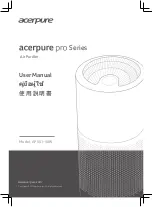
P5417054
3
▫
A room: Properly insulate any refrigerant tubing run inside a room to prevent “sweating” that can
cause dripping and water damage to wall and floors.
▫
Damp or uneven areas: Use a raised concrete pad or concrete blocks to provide a solid, level
foundation for the unit to prevent water damage and abnormal vibration.
▫
An area with high winds: Securely anchor the outdoor unit down with bolts and a metal frame.
Provide a suitable air baffle.
▫
A snowy area: Install the outdoor unit on a raised platform that is higher than drifting snow. Provide
snow vents.
●
Do not install the unit in the following places. Doing so can result in an explosion, fire, deformation,
corrosion, or product failure.
▫ Explosive or flammable atmosphere
▫ Where a fire, oil, steam or powder can directly enter the unit, such as nearby or above a kitchen
stove.
▫
Where oil (including machinery oil) may be present.
▫ Where corrosive gases such as chlorine, bromine, or sulfide can accumulate, such as near a hot
tub or a hot spring.
▫ Where dense, salt-laden airflow is heavy, such as in coastal regions.
▫
Where the air quality is of high acidity.
▫
Where harmful gases can be generated from decomposition.
●
Do not install the decorative panel with motion sensor and radiation sensor (P-AP160NAE1) in the
following places. It may cause failure or deterioration of the sensor.
▫
Ambient temperature changes drastically.
▫
Where excessive force or vibration is applied to the sensor.
▫
Where static electricity or electromagnetic waves may generate.
▫
Where interference of infrared light such as glasses or mist is in the detecting area.
▫
Where the lens for sensor is exposed in high temperature and humidity for a long time.
▫
W
here fluid and corrosive gas exist.
▫
Where direct lights such as sunlight or headlight affect the sensor.
▫
Where hot air from a heater, etc. affects directly to the sensor.
▫
W
here the air flow returns to the sensor by hitting obstacles such as shelf, locker, etc.
▫
W
here the blower devices such as ceiling fan, ventilating fan, etc. affect the air flow from the
indoor unit.
▫
Where weather affects directly the surface of the sensor.
▫
Where the lens surface may smudge or be damaged such as a dusty environment.
Detecting function will decrease if the lens for sensor smudges.
In this case, wipe off smudges using a cotton swab soaked with alcohol (Isopropyl alcohol is
recommended.) or a soft cloth. (When wiping off smudges on the lens for sensor, do not apply
excessive force. If excessive force is applied, the resin lens may be damaged and this may cause
malfunctions such as misdetection or undetectable of the motion.)
●
Do not position the condensate pipe for the indoor unit near any sanitary sewers where corrosive
gases may be present. If you do, toxic gases can seep into breathable air spaces and can cause
respiratory injuries. If the condensate pipe is installed incorrectly, water leakage and damage to the
ceiling, floor, furniture, or other possessions may result. If the condensate pipe becomes clogged,
water may drip from the indoor unit. Do not install the indoor unit where such dripping can cause
moisture damage or uneven locations: Use a raised concrete pad or concrete blocks to provide a
solid, level foundation for the unit to prevent water damage and abnormal vibration.
●
Before performing any brazing work, be sure that there are no flammable materials or open flames
nearby.
●
Perform a test run to ensure normal operation. Safety guards, shields, barriers, covers, and protective
devices must be in place while the compressor/unit is operating. During the test run, keep fingers and
clothing away from any moving parts.
●
Clean up the site when finished, remembering to check that no metal scraps or bits of wiring have
been left inside the unit being installed.
After installation work for the system has been completed, explain the “Safety Precautions,” the proper use
and maintenance of this unit to the customer according to the information in all manuals that came with the
system. All manuals and warranty information must be given to the user or left near the Indoor Unit.








































